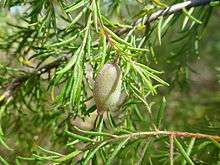Persoonia hirsuta
| Persoonia hirsuta | |
|---|---|
 | |
| flower, Boree Track, NSW | |
| Scientific classification | |
| Kingdom: | Plantae |
| (unranked): | Angiosperms |
| (unranked): | Eudicots |
| Order: | Proteales |
| Family: | Proteaceae |
| Genus: | Persoonia |
| Species: | P. hirsuta |
| Binomial name | |
| Persoonia hirsuta Pers. | |
Persoonia hirsuta, commonly known as the hairy persoonia or hairy geebung, is a shrub native to New South Wales in eastern Australia.[2]
First collected by John White in the vicinity of Port Jackson (Sydney) in 1794, Persoonia hirsuta was described by Christiaan Hendrik Persoon in his 1805 work Synopsis Plantarum.[3] The species name hirsuta is the Latin adjective hirsutus "covered with long coarse hairs", and refers to the hairy nature of the plant.[4]
Two subspecies are recognised: the nominate subspecies hirsuta is found within 20 km (12 miles) of the New South Wales Central Coast up to 300 m in altitude. It ranges from Gosford to the Royal National Park. Subspecies evoluta is found further inland in the Sydney region, from Hill Top in the southwest to Glen Davis in the northwest and Putty to the north.[1] The subspecies are distinguished by leaf shape, the former having narrow linear leaves, 0.75 to 1.5 mm wide, with revolute margins, and the latter spoon- or oval-shaped (spathulate to elliptic) leaves measuring 1.5 to 5 mm wide, with recurved margins.[5] There is a wide zone where intermediate forms are found from the Lower Blue Mountains to 15 km (8 mi) of the coast. Subspecies evoluta also hybridises with P. mollis subsp. nectens.[6]
Persoonia hirsuta grows as a low spreading shrub to 1 m (3 ft) high,[4] distinguished from other persoonias by its hairy leaves, stems and flowers. The yellow flowers appear from November to January,[7] and are followed by the development of fleshy fruit known as drupes which fall to the ground when mature.[6]
The usual habitat is open woodland and heath on sandstone soils.[6]
The fruit are adapted to be eaten by vertebrates, such as kangaroos, possums, and currawongs and other large birds.[6]
Persoonia hirsuta is listed nationally as endangered. The species occurs in fragmented small populations throughout its range. It is threatened by urban development and clearing or degradation of bushland, and too frequent bushfires and burning of bush.[1] The European honeybee has been implicated in the decline of this and other species as it is suspected of being a poor pollinator of persoonia flowers.[1]

References
- 1 2 3 4 Persoonia hirsuta, Species Profile and Threats Database, Department of the Environment and Heritage, Australia.
- ↑ "Persoonia hirsuta Pers.". Australian Plant Name Index (APNI), IBIS database. Centre for Plant Biodiversity Research, Australian Government.
- ↑ Persoon, Christiaan Hendrik (1805). Synopsis plantarum, seu enchiridium botanicum, complectens enumerationem systematicam specierum hucusque cognitarum (in Latin). 1. Paris, France: Apud Carol. Frid. Cramerum. p. 118.
villoso-hirsuta, fol. linearibus margine revolutis
- 1 2 Wrigley, John; Fagg, Murray (1991). Banksias, Waratahs and Grevilleas. Sydney, New South Wales: Angus & Robertson. pp. 486–87. ISBN 0-207-17277-3.
- ↑ P.H. Weston. "New South Wales Flora Online: Persoonia hirsuta". Royal Botanic Gardens & Domain Trust, Sydney, Australia.
- 1 2 3 4 Benson, Doug; McDougall, Lyn (2000). "Ecology of Sydney plant species: Part 7b Dicotyledon families Proteaceae to Rubiaceae" (PDF). Cunninghamia. 6 (4): 1017–1202.
- ↑ Fairley, Alan; Moore, Philip (2000). Native Plants of the Sydney District: An Identification Guide (2nd ed.). Kenthurst, New South Wales: Kangaroo Press. p. 158. ISBN 0-7318-1031-7.
| Wikimedia Commons has media related to Persoonia hirsuta. |
